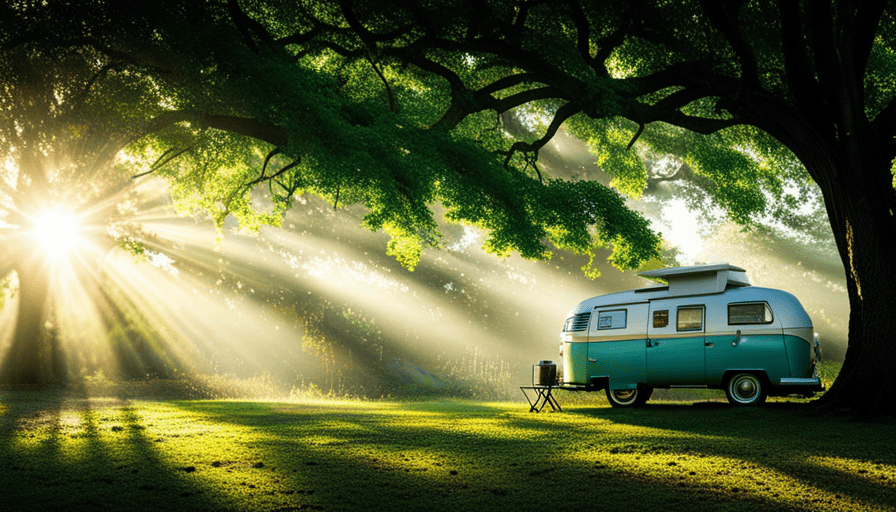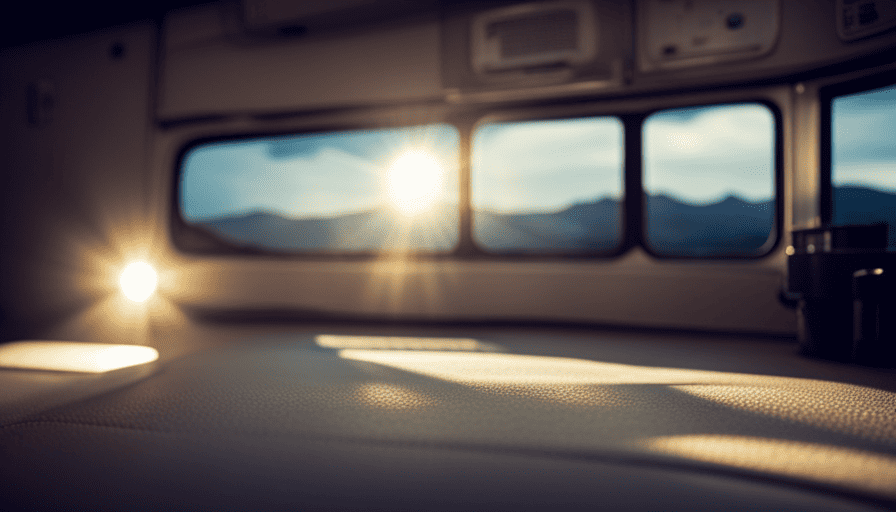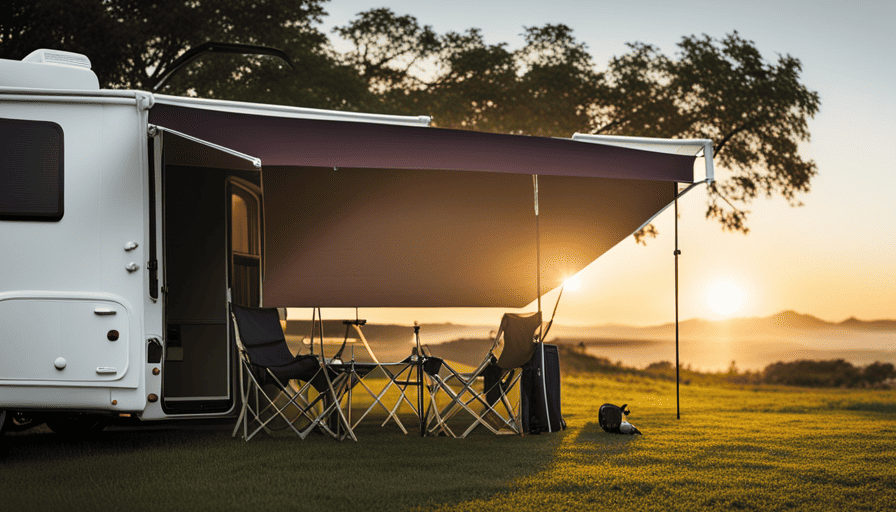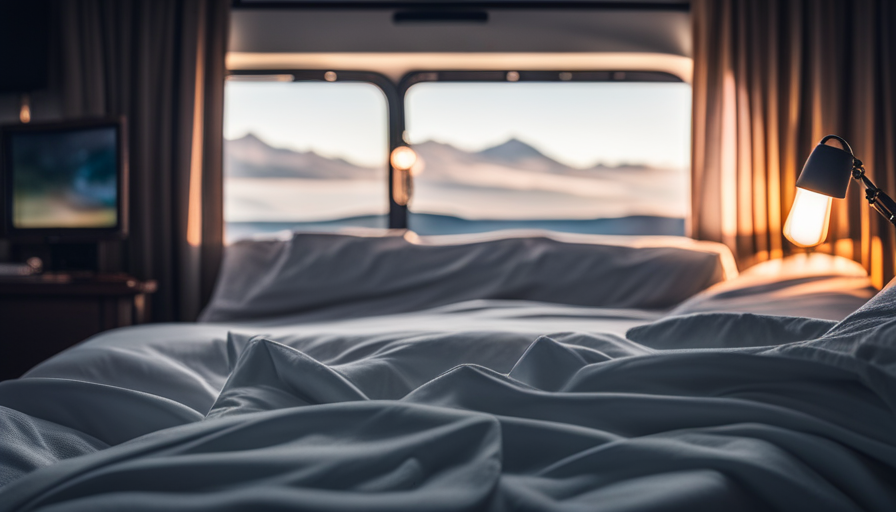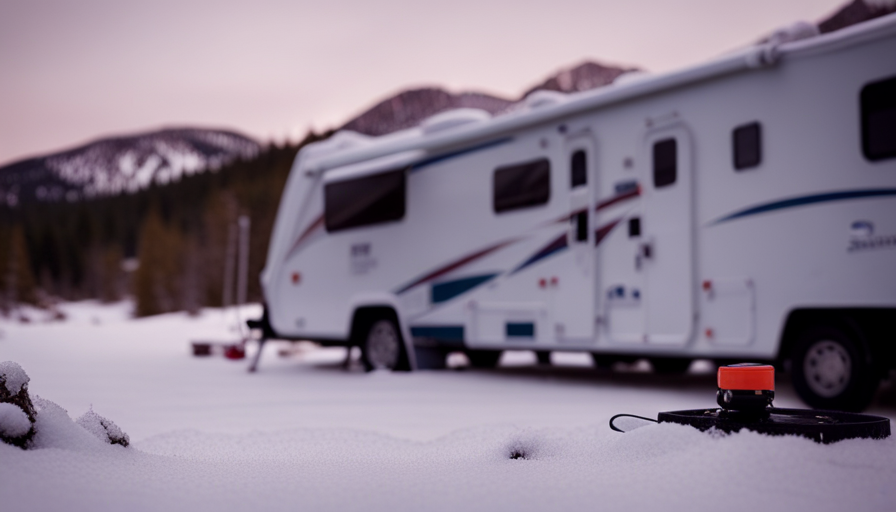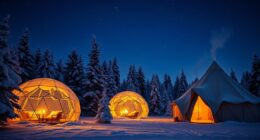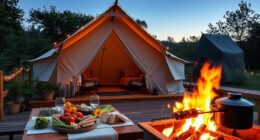Camping during the summer can become an exciting adventure, but fear not! I am here to share my tried and true tips on keeping a cool atmosphere inside your camper on those scorching days.
By optimizing airflow, insulating your camper, and creating shade, you’ll stay as cool as a cucumber. Don’t forget to bring along cooling devices and limit heat sources inside your camper.
Take advantage of natural cooling methods and choose campsites with electrical hookups for added comfort. Planning activities for cooler times of the day is a smart move, and ensuring a cool night’s sleep is essential.
With my practical and experienced advice, you’ll be able to beat the heat and enjoy your summer camping adventures to the fullest. So, let’s dive in and discover the secrets to keeping your camper cool all summer long!
Key Takeaways
- Optimize airflow by opening windows and vents
- Use window shades or reflective covers to block out direct sunlight
- Insulate your camper with foam panels or thermal curtains
- Use cooling devices like air conditioners, portable fans, and evaporative coolers
Optimize Airflow in Your Camper
Stay cool and comfortable this summer by optimizing the airflow in your camper! One of the best ways to beat the heat is to maximize ventilation inside your camper. Start by opening windows and vents to allow fresh air to circulate throughout the space.
Consider installing a roof vent or a fan to further enhance airflow. These additions can help prevent heat buildup by expelling hot air and bringing in cooler air from outside.
Another effective way to keep your camper cool is to strategically position your windows and vents. Open windows and vents on opposite sides of the camper to create cross ventilation. This will allow air to flow freely and cool down the interior. You can also use window shades or reflective covers to block out direct sunlight and reduce heat transfer.
In addition to optimizing airflow, insulating your camper can also help maintain a comfortable temperature. Insulating materials, such as foam panels or thermal curtains, can help regulate the temperature inside your camper by minimizing the transfer of heat. This will not only keep you cooler in the summer but also warmer in the winter.
By maximizing ventilation and preventing heat buildup, you can ensure a cool and comfortable summer in your camper. Now, let’s move on to the next section and learn how to insulate your camper for even better temperature control.
Insulate Your Camper
Make sure you’ve got your camper properly insulated so you can enjoy a comfortable and refreshing escape from the heat during those scorching summer days. Insulating your camper not only helps to keep the temperature down, but it also helps to reduce the amount of energy needed to cool it.
There are several options available when it comes to camper insulation, and it’s important to choose energy-efficient materials that are suitable for your specific needs. One popular option for camper insulation is foam board insulation. This type of insulation is lightweight and easy to install, making it a great choice for DIY projects. Another option is reflective insulation, which works by reflecting the sun’s heat away from your camper. This type of insulation is often used in combination with other insulation materials for maximum effectiveness.
When insulating your camper, it’s important to pay attention to areas that are prone to heat transfer, such as windows and doors. Adding insulation to these areas can help to prevent hot air from entering your camper and keep the cool air inside.
Transitioning into the subsequent section about creating shade around your camper, it’s important to remember that insulation is just one part of keeping your camper cool in the summer. Another effective way to beat the heat is by creating shade around your camper.
Create Shade Around Your Camper
To truly beat the heat and enjoy a refreshing escape, it’s time to get creative and provide some much-needed shade around your camper.
Creating an outdoor dining area is a great way to enjoy your meals while staying cool. You can set up a folding table and chairs under a large umbrella or canopy. This will not only shield you from the direct sunlight but also create a comfortable space to relax and enjoy your meals.
Another option is to set up a hammock area. Hanging a hammock between two trees or using a portable hammock stand can provide a shaded spot for lounging and napping. You can even add some string lights or lanterns to create a cozy ambiance for evening relaxation.
When setting up shade around your camper, it’s important to consider the direction of the sun and position your shaded areas accordingly. This will help maximize the effectiveness of your shade setup and keep you cool throughout the day.
In the next section, we will explore how to use cooling devices to further enhance your camper’s comfort. But before we dive into that, let’s focus on creating a comfortable and shaded outdoor space for you to enjoy.
Use Cooling Devices
When it comes to keeping my camper cool in the summer, I’ve found that using cooling devices is essential. Installing an air conditioner is a game-changer because it provides instant relief from the heat.
Portable fans are also a must-have as they help circulate the air and create a breeze inside the camper.
Additionally, utilizing evaporative coolers can be effective in dry climates because they use water to cool the air.
Overall, these cooling devices are a lifesaver when it comes to staying comfortable in the summer heat.
Install an Air Conditioner
Installing an air conditioner can greatly enhance the comfort of your camper during the sweltering summer months. When it comes to installing an air conditioner in your camper, one option to consider is using solar panels to power it.
Solar panels are a sustainable and eco-friendly way to generate electricity, and they can easily be installed on the roof of your camper. By harnessing the power of the sun, you can keep your camper cool without relying on traditional electricity sources. This not only saves energy but also reduces your carbon footprint.
However, if installing solar panels is not an option for you, there are other ways to keep your camper cool. One alternative is to use portable fans, which can provide a refreshing breeze inside your camper.
With these simple measures, you can stay cool and comfortable during your summer camping adventures.
Use Portable Fans
After considering the option of installing an air conditioner in your camper, let’s explore a more portable and cost-effective solution: using portable fans. These handy devices can provide a refreshing breeze and help keep the inside of your camper cool during the hot summer months.
To optimize fan placement, consider positioning them strategically near windows or vents to create a cross breeze. This will maximize air circulation and create a more comfortable environment.
When choosing a portable fan, look for features such as adjustable speed settings, oscillation capabilities, and a compact design for easy portability. Some fans even come with built-in timers or remote controls for added convenience.
By incorporating these tips and utilizing the right portable fan, you can beat the heat and enjoy a comfortable camping experience.
Now, let’s move on to the next section and discuss how to utilize evaporative coolers.
Utilize Evaporative Coolers
To create a more refreshing and enjoyable camping experience, harness the power of evaporative coolers. When it comes to keeping campers cool in the summer, these devices are a game-changer. Unlike traditional air conditioners, evaporative coolers are portable and use a natural cooling process. They work by drawing in warm air and passing it through a moistened pad, which cools the air through evaporation. This process not only provides a pleasant breeze but also adds moisture to the air, making it more comfortable in dry climates.
One of the main benefits of evaporative coolers is that they’re energy-efficient and eco-friendly, using a fraction of the electricity consumed by air conditioners. By utilizing these evaporative cooling alternatives, campers can stay cool and comfortable even in the hottest summer days.
Transitioning into the next section, it’s also important to limit heat sources inside the camper to maximize the cooling effect.
Limit Heat Sources Inside the Camper
In order to maintain a cooler temperature inside the camper during the summer months, it’s essential to minimize the presence of heat sources. By implementing a few simple strategies, you can effectively limit the amount of heat that enters your camper and create a more comfortable living space.
-
Minimize sunlight: One of the most effective ways to reduce heat inside the camper is to minimize direct sunlight. Park your camper in a shaded area or use awnings and sunshades to block out the sun’s rays.
-
Use reflective materials: Another way to keep your camper cool is to use reflective materials on the windows and roof. Reflective window film or shades can help to bounce the sun’s rays away from the camper, preventing excessive heat buildup.
-
Insulate your camper: Proper insulation is key to keeping heat outside where it belongs. Make sure your camper is well-insulated, paying special attention to windows, doors, and any other areas where heat can easily seep in.
-
Reduce cooking indoors: Cooking inside the camper can generate a significant amount of heat. Whenever possible, try to cook outdoors or use a portable stove to minimize heat sources inside.
By implementing these strategies, you can significantly reduce the amount of heat inside your camper and create a more comfortable living environment. Stay hydrated and dress appropriately to further beat the summer heat.
Stay Hydrated and Dress Appropriately
Stay comfortable and beat the scorching heat by staying hydrated and dressing appropriately for the summer months in your camper.
To stay cool, it’s crucial to drink plenty of water throughout the day. Dehydration can lead to fatigue and heatstroke, so it’s important to keep a water bottle handy and sip on it regularly.
Dressing appropriately is equally important. Opt for lightweight, breathable fabrics like cotton or linen that allow air circulation and help wick away sweat. Wearing loose-fitting clothes also helps in keeping your body cool. Don’t forget to apply sunscreen to protect your skin from harmful UV rays and avoid sunburn.
In addition to staying hydrated and dressing appropriately, there are other ways to keep cool in your camper. Take advantage of natural cooling methods such as parking your camper in shaded areas or under trees, using reflective window coverings to block out the sun’s rays, and opening windows or vents to promote air circulation.
These simple steps will help maintain a comfortable temperature inside your camper and ensure a more enjoyable summer camping experience.
Take Advantage of Natural Cooling Methods
When camping in the summer, it’s important to take advantage of natural cooling methods to stay comfortable.
One way to do this is by camping near bodies of water, such as a lake or river. The cool breeze and evaporation can help lower the temperature.
Another tip is to open windows and roof vents at night. This allows for better airflow and releases any built-up heat inside the camper.
Lastly, using natural shade from trees or rocks can provide relief from the direct sunlight. It helps keep the camper cooler throughout the day.
Camp near Bodies of Water
One surefire way to beat the summer heat while camping is by pitching your tent near a refreshing lake or river – you’ll feel like you’re in an Arctic wonderland! Not only does this provide a stunning view, but it also offers a natural cooling effect. The cool breeze that comes off the water can make a significant difference in temperature, making your camping experience more comfortable. Plus, it provides an opportunity for water activities like swimming or fishing. Check out the table below for some tips on campfire safety and wildlife encounters.
| Campfire Safety | Wildlife Encounters |
|---|---|
| Keep fire small | Store food properly |
| Clear area of debris | Secure trash cans |
| Extinguish completely | Avoid approaching wildlife |
By camping near a body of water, you can enjoy the coolness during the day and then open windows and roof vents at night for added ventilation. This allows for a comfortable and refreshing sleep, preparing you for another adventurous day in the great outdoors.
Open Windows and Roof Vents at Night
When camping in the summer, it’s important to find ways to keep cool and comfortable. One effective method is to camp near bodies of water, as they provide a natural source of cooling.
However, if you find yourself in a location without water nearby, there are other strategies you can employ. One such strategy is to optimize ventilation by opening windows and roof vents at night. This allows for a cross breeze to circulate through the camper, effectively reducing heat transfer and keeping the interior cooler. I’ve found this method to be incredibly effective in maintaining a comfortable temperature inside the camper during hot summer nights.
By maximizing airflow, you can create a refreshing environment that allows for a good night’s sleep.
Speaking of staying cool, another technique that works wonders is to use natural shade from trees or rocks. This provides a natural barrier against the sun’s rays and helps to keep the camper cooler throughout the day.
Use Natural Shade from Trees or Rocks
To stay comfortable in the heat, try taking advantage of the natural shade provided by trees or rocks. Natural shade offers a number of benefits when it comes to keeping your camper cool during the summer months.
Here are some alternative cooling methods that can help you beat the heat:
-
Trees provide a cooling effect by blocking direct sunlight and reducing the temperature around your camper. They also offer a pleasant and calming atmosphere, making your camping experience more enjoyable.
-
Rocks can absorb and radiate heat, creating a natural cooling effect. Positioning your camper near a large rock formation can provide additional shade and help lower the temperature inside.
-
Using a combination of trees and rocks can create a natural barrier, blocking hot winds and maintaining a comfortable temperature inside your camper.
By utilizing natural shade, you can significantly reduce the need for artificial cooling methods. However, if natural shade is not available, there are other strategies to keep your camper cool. Transitioning to the next section, choosing campsites with electrical hookups provides the opportunity to use powered fans or air conditioners for added comfort.
Choose Campsites with Electrical Hookups
If you want to keep yourself cool while camping in the summer, you gotta choose campsites with electrical hookups. Having access to electricity at your campsite can make a world of difference when it comes to beating the heat. Not only can you use fans and air conditioning units to stay cool, but you can also keep your electronics charged and have access to a reliable power source for cooking and refrigeration.
To help you find campsites with electrical hookups, here’s a handy table that outlines the benefits and ways to locate these sites:
| Benefits of Electrical Hookups | How to Find Campsites with Electrical Hookups |
|---|---|
| Stay cool with fans and AC | Check campground websites or directories |
| Charge electronics | Use camping apps or websites for reviews |
| Power for cooking and refrigeration | Call campgrounds and ask about amenities |
By choosing campsites with electrical hookups, you can ensure a comfortable and enjoyable camping experience, even during the hottest summer days. Now, let’s move on to the next topic and learn how to plan activities for cooler times of the day.
Plan Activities for Cooler Times of the Day
Planning activities for the cooler times of the day allows me to make the most out of my camping experience and fully enjoy the pleasant temperatures. When the sun is high and the heat is scorching, it’s important to find ways to stay cool and avoid overheating. By strategically planning activities during the cooler parts of the day, I can ensure that I have a comfortable and enjoyable time outdoors.
One of the best ways to plan activities for cooler times is to take advantage of the early morning and late evening hours. During these times, the temperatures are usually cooler, and the sun is not as intense. This is the perfect time to go for a hike, explore the surrounding nature, or engage in any physically demanding activities.
Additionally, planning activities during cooler times also allows me to take advantage of the beautiful scenery and peacefulness that comes with these times of the day. Whether it’s watching the sunrise or enjoying the sunset, these moments can be truly magical and add an extra layer of enjoyment to my camping experience.
By planning activities for cooler times, I can beat the heat and truly appreciate the beauty of nature around me. Now, let’s move on to the next section and explore how to stay cool at night without compromising on comfort.
Stay Cool at Night
When it comes to staying cool at night while camping, I’ve found a few tricks that have worked wonders for me.
One of the best things I’ve discovered is using cooling mattress toppers or pads, which help regulate body temperature and provide a comfortable sleep surface.
Additionally, opting for lightweight bedding and breathable fabrics can make a world of difference in keeping cool throughout the night.
Lastly, positioning fans strategically in the sleeping area can help circulate air and create a refreshing breeze.
Use Cooling Mattress Toppers or Pads
To beat the summer heat while camping, consider using a cooling mattress topper or pad for a more comfortable night’s sleep. Cooling mattress technology has come a long way, and these toppers are designed to regulate your body temperature and keep you cool throughout the night.
The benefits of using mattress toppers are numerous. They provide extra cushioning and support, while also wicking away moisture and heat. This means you’ll wake up feeling refreshed and ready to take on the day, even in the hottest of temperatures.
As you transition into the next section about using lightweight bedding and breathable fabrics, it’s important to note that combining a cooling mattress topper with these materials will further enhance your comfort and help you stay cool during those sweltering summer nights.
Use Lightweight Bedding and Breathable Fabrics
Using lightweight bedding made from breathable fabrics can greatly enhance your camping experience during the hot summer months. Here are three benefits of using lightweight bedding and some breathable fabric options to consider:
-
Improved air circulation: Lightweight bedding allows for better airflow, preventing heat from getting trapped and keeping you cool throughout the night.
-
Moisture-wicking properties: Breathable fabrics like cotton or bamboo are known for their ability to wick away moisture from your body, helping you stay dry and comfortable even in humid conditions.
-
Portability and easy maintenance: Lightweight bedding is easy to pack and carry, making it convenient for camping trips. Additionally, these fabrics are often machine washable and quick-drying, making them low-maintenance options for outdoor adventures.
By using lightweight bedding made from breathable fabrics, you can ensure a comfortable and cool sleep while camping.
Now, let’s discuss how to position fans to circulate air in the sleeping area.
Position Fans to Circulate Air in the Sleeping Area
After ensuring that the bedding and fabrics in my camper are lightweight and breathable, the next step to keeping cool in the summer is strategically positioning fans to circulate air in the sleeping area.
Fan placement plays a crucial role in improving air circulation and creating a comfortable environment. One effective strategy is to place one fan near the window, facing inward, to draw in fresh air from outside. Another fan can be positioned on the opposite side of the room, facing outward, to push out stale air. This creates a cross-breeze that helps cool down the space.
Additionally, using oscillating fans can help distribute air more evenly throughout the room. By implementing these air circulation strategies and optimizing fan placement, I can ensure a cool and refreshing sleep during those hot summer nights in my camper.
Frequently Asked Questions
How can I prevent my camper from getting too hot during the day?
To prevent my camper from getting too hot during the day, I’ve found that using portable cooling options and effective insulation methods are key.
I’ve tried various portable cooling options, such as portable fans and air conditioners. They help to circulate the air and keep the temperature down.
Additionally, I make sure to properly insulate the camper. I use window coverings, reflective insulation, and seal any gaps or cracks.
This combination has proven to be effective in keeping my camper cool and comfortable, even on the hottest summer days.
Are there any portable air conditioning units available for campers?
Yes, there are portable air conditioning units available for campers. These units are designed to provide cooling relief in small spaces like campers. They are compact, lightweight, and easy to install.
However, if you don’t have access to a portable air conditioning unit, there are alternative cooling methods you can try. These include using fans, opening windows strategically for cross ventilation, and using reflective window coverings to block out the sun’s heat.
What are some tips for keeping the interior of my camper cool while I’m away?
To keep the interior of my camper cool while I’m away, I’ve found a few helpful tips. First, I make sure to reduce humidity by using a dehumidifier or opening windows to allow for air circulation.
Additionally, insulating the camper is crucial for hot weather. I use reflective window covers, insulate the roof and walls, and seal any gaps or cracks.
These methods have proven effective in keeping my camper cool and comfortable during those scorching summer days.
Can I use a portable fan to help cool down my camper?
Yes, using a portable fan can be a great way to cool down your camper. It not only provides instant relief from the heat but also helps to circulate the air and create a more comfortable environment. However, it’s important to note that a portable fan should be used in conjunction with other cooling methods. For example, keep windows and doors closed during the hottest parts of the day, use reflective window coverings, and utilize shade from trees or awnings.
Are there any specific types of clothing or fabrics that are better for staying cool in a camper during the summer?
When it comes to staying cool in a camper during the summer, choosing the right clothing and fabrics can make a big difference. Opt for lightweight and breathable materials like cotton or linen, as they allow air to flow and help to wick away moisture from your body. Avoid synthetic fabrics as they tend to trap heat. Loose-fitting clothes in light colors can also help reflect the sun’s rays and keep you cooler.
Can Keeping Water Lines from Freezing in a Camper Also Help in Keeping the Camper Cool in Summer?
Yes, knowing how to prevent frozen water lines in a camper can also be beneficial in keeping the camper cool in the summer. Proper insulation and sealing can help regulate the temperature, preventing both freezing and excessive heat buildup. Additionally, using reflective window coverings can also help reflect heat away from the camper.
Conclusion
So there you have it, my fellow campers! By following these tips, you’ll be able to keep your camper cool in the summer like a pro.
With optimized airflow, insulation, shade, cooling devices, and limiting heat sources, you’ll be able to beat the scorching heat. And let’s not forget about taking advantage of natural cooling methods and choosing campsites with electrical hookups.
So go ahead, plan your activities for cooler times of the day and enjoy a cool and comfortable camping experience. Stay cool, my friends!

